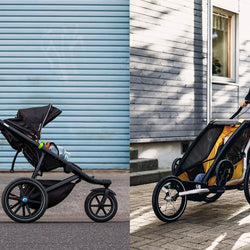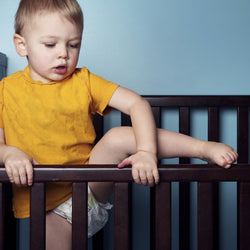Education Begins at Birth: Growing Baby's Brain

by Jeff & Annie Wiesman
Jul 18, 2018
During the first year of Baby’s life, plenty of varied stimulation will foster brain growth. Infants’ brains are like sponges, and they will develop when parents show affection and demonstrate love through words and actions.
Learning begins as babies explore their immediate surroundings and their own bodies. From birth, you can create an environment of growth, often in ways you would naturally interact with your baby.
Simple Types of Stimulation for a Healthy Growth Environment
- Hold your baby, gently rock her, and walk around with her in your arms.
- Tickle her toes, touch her nose, gently wiggle her arms or rub her head, and softly blow on her tummy.
- Make lots of eye contact.
- Go for a short car ride, take a walk with her in a stroller, or swing her in a cradle.
- Make fun faces with her—smile, stick out your tongue, and wiggle your nose.
- Play music, sing songs, and make silly noises.
- Show pictures of your family and talk about what is seen in them. Hold the pictures about ten to twelve inches away from Baby’s face.
- Say your newborn’s name often.
- Schedule play dates with other parents and babies.
- Let them touch objects so they are able to explore size, texture, and weight.
- Regularly talk to your infant. Don’t underestimate the value of regular communication, especially in this electronic age. People who have studied device usage and caregiver relationships note how parents tend to be less responsive and have fewer conversations with their young children because of the tendency to get absorbed with a smart phone.
Be Aware of Inappropriate Stimulation
The key is to provide appropriate stimulation. For example, screen time can stunt development. In fact, the American Academy of Pediatrics recommends avoiding screen media for children younger than 18 months (with the exception of video-chatting with family and friends).
It is also important to be careful not to over stimulate your baby, because too much stimuli can actually hinder growth.
Article Continues Below Advertisement
So periodically allow time for your baby to simply explore her surroundings without background noise or too much visual play.
Create an Environment for Creative Play and Exploration
Once your infant is around five to six months old, he will begin to base his actions on conscious decisions and he will have the increased ability to engage with toys. At this point you can introduce additional playthings such as blocks, rings, and a baby xylophone.
When you introduce him to new activities, simply provide the materials and see what happens. Let him explore and discover without direction or promptings. A lot of learning happens with just personal experimentation, and while you may not know it, he is starting to develop an understanding of the world around him while he plays.
Simply sit with your child, show interest, and talk with him as he explores. As you play with objects or investigate your surroundings, state the name of what you see. Observe what he does with the toys, how he holds them, and how long they keep his attention.
Article Continues Below Advertisement
While you engage with your baby, he will also develop language skills simply by hearing your voice and imitating your words and actions. Ask questions about the look, feel and noise a toy makes. You will help your baby create a learning foundation they will later tap into.
The best way to begin an education at birth is to realize the power of play and provide multiple experiences. As you allow your baby to use their eyes, ears, hands, and other senses to play, you will foster development in all areas: cognitively, physically, socially, and emotionally.
Jeff & Annie Wiesman
Dr. Jeff & Annie Wiesman are coauthors of “Education Begins at Birth: A Parent’s Guide to Preparing Infants, Toddlers, and Preschoolers for Kindergarten.” Jeff is an associate professor of education who mentors future elementary school teachers, and Annie has numerous years of experience teaching preschool, kindergarten, and first grade. They reside in New York with their five-year-old daughter.










